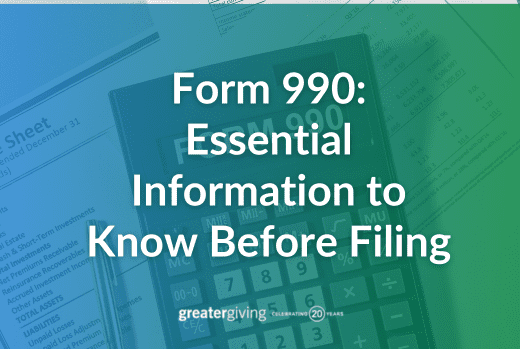
Maintaining 501(c)(3) tax-exempt status is one of the most important aspects of running your nonprofit. To preserve your status and make the most of your donations, your nonprofit has to file tax forms on an annual basis. The form that most nonprofits need to file is the IRS Form 990.
Organizations that miss the filing deadline face penalty fees and the eventual loss of their 501(c)(3) status. This usually happens because Form 990 requires a lot of information, meaning some nonprofits run out of time to file. But, by educating yourself about Form 990, you’ll be more prepared to tackle it in a timely manner and meet the deadline every year. Let’s explore the fundamentals of Form 990 so you can expedite the filing process.
Why is filing Form 990 important?
If your nonprofit didn’t have 501(c)(3) status, you would need to put a significant chunk of your valuable fundraising revenue towards paying taxes. The 501(c)(3) tax-exempt status allows nonprofits to effectively pursue their mission and achieve their goals.
Additionally, holding tax-exempt status is a significant draw for donors to give. A major benefit of donating to a tax-exempt organization for the donor is that they can deduct the donation value from their owed taxes. Thus, retaining 501(c)(3) status helps keep donors happy and willing to give in the future.
Who needs to file Form 990?
While most nonprofits (besides religious organizations) need to file some form of IRS paperwork to exempt themselves from taxes, the exact form required depends on your nonprofit’s gross receipts and assets. According to File990, Form 990 is for nonprofits with gross receipts of at least $200,000 and total assets of $500,000 or more. If your organization falls beneath these benchmarks, you’ll need to file Form 990-EZ or Form 990-N.
What information do I need to file Form 990?
Like other tax forms, Form 990 requires nonprofit filers to disclose their financial information, such as revenue, gross receipts, expenses, and assets. This is to prove that the nonprofit is following the regulations put in place to prevent donation fraud or embezzlement.
Form 990 is designed to paint a detailed picture of your nonprofit for the IRS. Thus, some of the information required on Form 990 goes beyond financial data. The IRS might ask for information
about:
● How the organization is governed
● Leadership, employees, and board members (names and salaries paid by the nonprofit)
● The organization’s mission and activities
Your nonprofit might also need to provide external attachments as part of your filing. Part IV of the form will provide a list of supplemental documents to include, such as Schedule B, Schedule
of Contributors, Schedule F, and Schedule G. All of these materials provide additional context about your nonprofit’s operations, such as your typical fundraising activities and legal standing.
The detail required on Form 990 means your nonprofit’s financial team should start collecting information and compiling reports well in advance. Ensure you research the necessary data and
attachments so you aren’t scrambling to compile them at the last minute!
When is the deadline for filing Form 990?
Your filing due date depends on when your nonprofit’s fiscal year ends. For most nonprofits, their fiscal year ends on June 30, making their due date May 15. If you miss your filing due date, you can file an extension request, but you might be penalized with significant late fees. That being said, your nonprofit finance department should prioritize filling out your tax forms on time (or filing for an extension early). In fact, filing ahead of schedule is ideal to guarantee that your nonprofit retains its 501(c)(3) tax-exempt status with the IRS.
How do I file Form 990?
Now that you know the basic elements of Form 990, you can begin planning your filing. In the past, nonprofits would fill out the form by hand. But this is a slow and laborious process that is
prone to human error. That being said, the best way to file your taxes is by using online software. In fact, the Taxpayer First Act requires your nonprofit to file online. But, you don’t have
to file on your own.
To help you get started, consider using tax filing software tailored for Form 990. These software solutions know the ins and outs of tax forms and ensure that you aren’t missing any important information or attachments. Plus, eFiling software is cost-effective compared to working with a CPA or other tax professional.
To get started with e-filing software, work with your team to determine which IRS form you qualify for, whether it’s the 990, 990-EZ, or 990-N. Then, research the options on the market and choose one based on your needs and price range. Your chosen solution should be user-friendly, affordable, and tailored for nonprofit taxes.
Wrapping Up
You should be mindful of your financial data year-round, not just during tax season. Keeping detailed and accurate financial records makes filing Form 990 that much easier. According to NPOInfo, making data hygiene part of your daily routine will streamline the filing process when tax season comes around. That way, you’re less likely to miss out on the amazing benefits of 501(c)(3) status and more likely to retain your donors for years to come.
